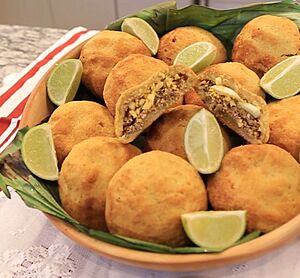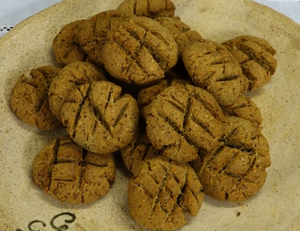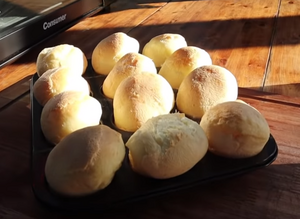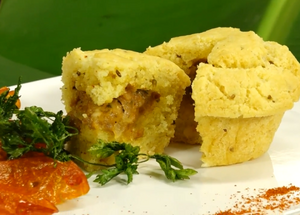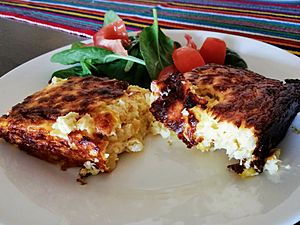Chipa facts for kids
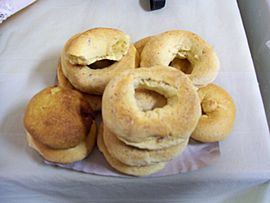 |
|
| Type | Bread |
|---|---|
| Course | Breakfast or snack |
| Place of origin | Paraguay |
| Main ingredients | Cassava starch, corn starch, fat, milk, egg, Paraguay cheese |
Chipa is a yummy, small, baked roll that tastes like cheese! It's a super popular snack and breakfast food in Paraguay. People have been making chipa since the 1700s. Its story began with the Guaraní people in a city called Asunción.
Chipa is usually cheap and easy to find. You can often buy it from street vendors or even on buses. Vendors carry big baskets filled with warm chipa wrapped in cloth. It's a delicious treat that many people enjoy!
The name chipa comes from the Guaraní language. If a chipa is small, it might be called a chipita. In some parts of Bolivia, like Santa Cruz de la Sierra, it's known as cuñapé. In parts of Argentina, people call it chipá or chipacito if it's tiny.
What is Chipa?
Chipa is often baked as small doughnut shapes or buns. These are sometimes called chipita or chipacitos. You can buy them in small bags from street sellers in cities and towns. Chipa doesn't use yeast, so it can stay fresh for many days, even in hot weather. It's a special food often found at religious celebrations.
There are many kinds of chipa in Paraguay. One type is chipa caburé or chipá mbocá. This one is cooked around a stick, so it doesn't have a soft center. Another kind is chipa so'o, which is filled with tasty ground meat. Other varieties use different ingredients. For example, chipa manduvi is made with corn flour and peanuts. Chipa avatí and chipa rora are made from parts of the corn seed, like a whole-wheat bread.
The History of Chipa
Did you know that chipa has a long history? A German traveler named Ulrich Schmidl wrote about a starchy bread made by the Cario-Guarani people way back in the 1500s. These native people lived near Asunción. Schmidl was on a Spanish ship that arrived in Asunción, which led to the first meeting between the Spanish and the Cario-Guarani.
Before it was called chipa, this bread was known as “mbujape.” In Guarani, “mbujape” simply means “bread.” To make mbujapé, people mixed corn flour or cassava starch with animal fat. Then, they wrapped it in a banana leaf and cooked it in hot ash.
Paraguayan cooking is a mix of Spanish and Cario-Guaraní traditions. This blend happened in Asunción and nearby areas, influenced by Spanish explorers and priests. Towns like Tobatí, Atyrá, Altos, Areguá, Ypané, Guarambaré, Itá, and Yaguarón show how Paraguayan culture grew.
The Cario-Guarani people hunted, fished, and grew grains. They had their own cooking methods and tools. When the Spanish arrived in Asunción, they brought new foods like cattle in 1556. This meant new ingredients like beef, milk, eggs, and cheese became available. So, the native foods like cassava, corn, and sweet potato mixed with Spanish ingredients. This blend created many of the delicious Paraguayan dishes we know today, including chipa!
Different Kinds of Chipa
Over time, the name "chipa" started to include many different side dishes that developed from the mix of Cario-Guaraní and Spanish cultures. Today, there are about 70 known types of chipa! A book called "Food and Paraguayan religiosity: Chipa, sacred bread" lists many of them. Here are some popular ones:
- Chipa aramirõ: This is the classic chipa made with starch. It's the most famous kind. Its ingredients include cassava starch, cheese, pork fat, and sometimes anise seeds.
- Chipa mestiza: This is the second most common type. Its name means "mixed" because it uses both corn flour and cassava starch.
- Instant chipa or Quick chipa: This chipa is super fast to make, taking only about 30 minutes! You just blend the ingredients and bake it for 10 minutes.
- Chipa four cheeses: This chipa is filled with four different kinds of cheese: Mozzarella, Catupiry, Paraguay Cheese, and sandwich cheese. Yum!
- Chipa chutita: This one adds cornstarch and baking powder to the dough. It's filled with a special sausage called "chorizo misionero," grated cheese, onions, and peppers.
- Chipa asador, caburé or mbocá: This chipa is cooked over hot coals around a stick. Because of this, it's long, thin, and hollow inside, not spongy. It's often called "chipa asador" in Paraguay.
- Chipa pirú or chipita: These are tiny, super crispy doughnut-shaped rolls, usually less than two centimeters wide. They are perfect for breakfast or snacks. "Pirú" means "skinny" or "dry" in Guarani, which describes these thin, dry, and crunchy chipas.
- Chipa so'o: This chipa is made from cassava starch dough and filled with seasoned meat. "So'o" means "meat" in Guarani. It's shaped like a small cake, about 7 centimeters wide, with a meat and chopped egg filling inside.
- Chipa guasu: This is a big corn cake baked in the oven. "Guazú" means "big" in Guarani, so it's "the big chipa." It's made with fresh corn, egg, water, salt, milk, fat, and cheese. It's a common dish during special times like Lent and Easter because it doesn't have meat. It can be savory or slightly sweet.
- Chipa quezú: This chipa is made with fresh cheese, often goat cheese. "Quezú" is how the Guarani language says "cheese."
- Chipa jasmine: This one uses a mix of cassava starch and wheat flour, along with cheeses, pork fat, and eggs. It's a lighter version because it doesn't have as much cassava starch.
- Chipa manduví: "Manduví" means "peanut" in Guarani. This chipa is made with a mix of cornmeal and ground peanuts.
- Chipa rorá: This chipa is made from the outer layer of corn seeds after they've been strained.
See also
 In Spanish: Chipa para niños
In Spanish: Chipa para niños


